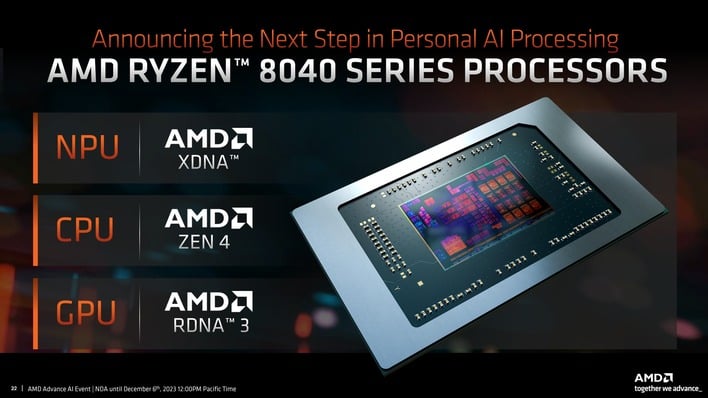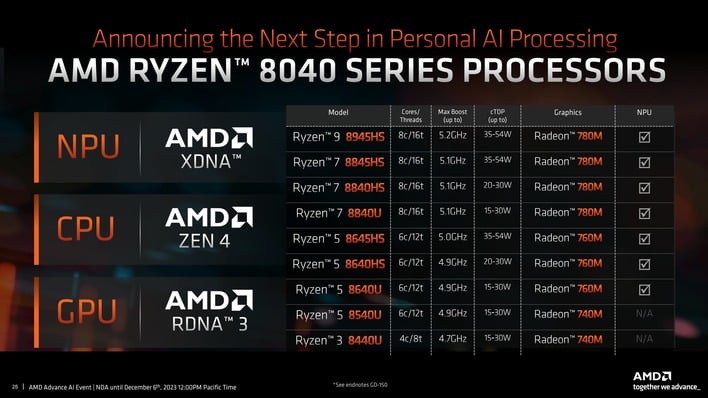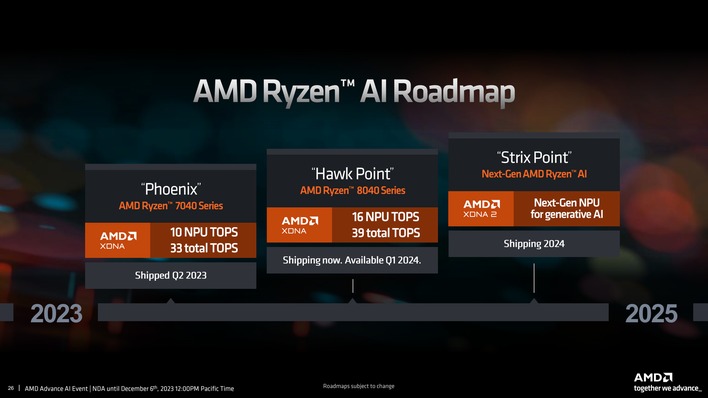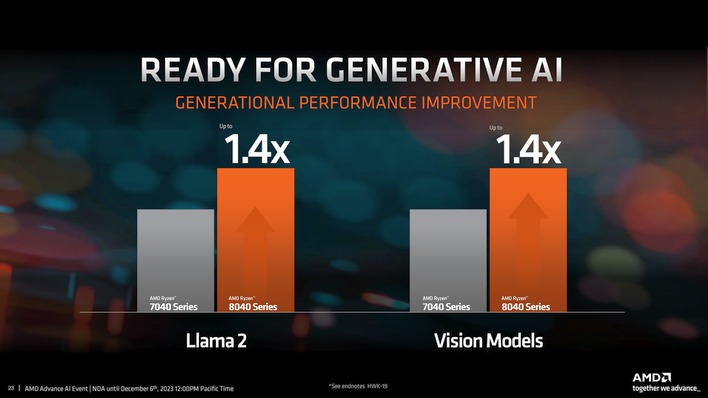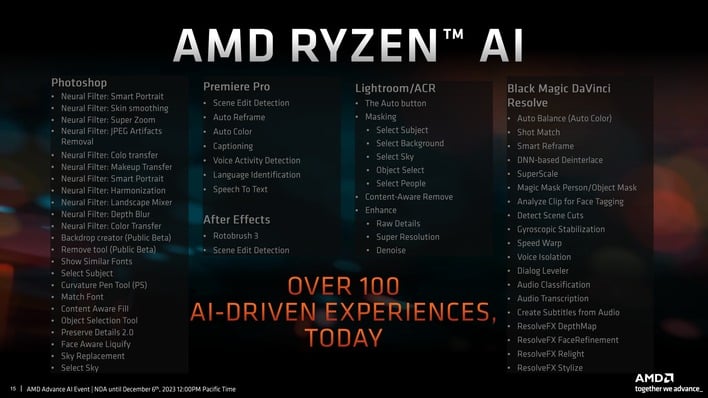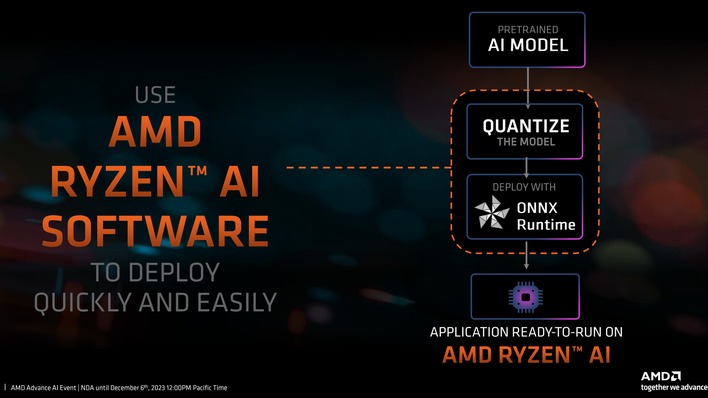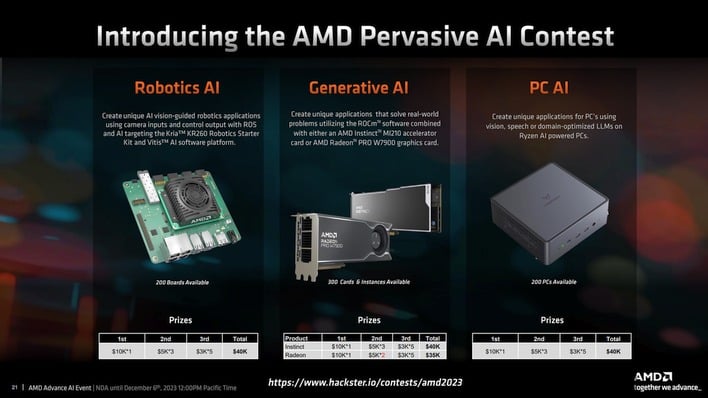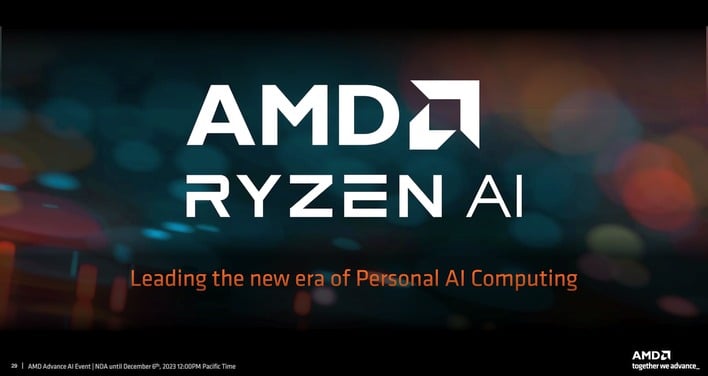AMD Announces Ryzen 8040 Series Mobile CPUs With Revamped Ryzen AI And A Nice Performance Bump
That's exactly why AMD emphasized the AI performance of its brand-new, just-announded Ryzen 8040 series processors at is "Advancing AI" event, where the company also detailed its Instinct MI300 family of accelerators.
As you read this, the Ryzen 8040 series is headed to factories where it'll be implemented into mobile devices and mini-PCs that you'll be able to buy early next year. In terms of CPU and GPU capabilities, these parts are fundamentally similar to the extant Ryzen 7040 series APUs, with up to eight Zen 4 CPU cores and up to twelve RDNA 3 compute units. NPU performance is really the only notable change in the "Hawk Point" Ryzen 8040 series over this year's "Phoenix". Check out the full lineup here:
There are lots of quizzical model number changes here; many processors got their last digit changed to a "5," which if we consult the AMD mobile processor model number decoder ring, means that they are "upper models within their segment." So, the Ryzen 9 7940HS gets replaced in the stack by the Ryzen 9 8945HS while the Ryzen 7 7840HS steps out for the Ryzen 7 8845HS, and so on.
Curiously, there's also a Ryzen 7 8840HS and a Ryzen 5 8640HS; these appear to be the exact same CPUs but with a lower 20-30W power range compared to the "35-54W" of most of the other parts. There are also a few "U" series processors that have a 15-30W power range. Two of these, the Ryzen 5 8540U and Ryzen 3 8440U, miss out on the NPU, which is kind of a bummer as that's apparently the biggest change in these chips.
AMD doesn't explain how it achieved this performance gain, but does say that it increases real-world AI performance by 40%, as measured in the Llama 2 large language model as well as in unspecified computer vision neural networks. We know the XDNA unit has an FPGA component, so AMD likely tweaked the programming and algos to optimize performance for various models.
Unfortunately, we haven't tested the actual Phoenix NPU throughput, so we can't intelligently comment on real-world performance, but we'd be surprised if it's particularly great across the board; NVIDIA claims 60 TOPS for a GeForce RTX 4060, for example. Of course, this is a low-power co-processor built into the CPU, so it's probably not fair to compare against a discrete GPU.
As AMD points out, there are two halves to handle when trying to bring new technologies to market. First, you've got to make the hardware and get it into the hands of both developers and those developers' customers. The company has already handled that part; Phoenix launched this year and the company says that it shipped "millions" of those processors already.
The second half of the equation is giving end users software that makes use of your new technology to add value. As AMD is primarily a hardware company, that means partnering with developers to get them to add support for XDNA into to their AI-equipped software. Apparently, AMD is working with many big names to get Ryzen AI working to accelerate the AI functions in popular software packages.
The company is so serious about getting developers working on its AI hardware that it is launching a contest with cash prizes called the AMD Pervasive AI contest. 35 lucky winners will get to pocket a cool few thousand dollars, ranging from $3,000 for a third-place finish to $10K on a first-place-win. Your goal? Make an AI application that can run on Ryzen AI. If you're curious about the context, check out this site.
As for the Ryzen 8040 series processors, AMD says that they're shipping out to customers now. We'll have to wait a bit to see some specific design wins, but we'd surmise that all of the usual suspects wil be on board, since they're effectively a drop-in replacement for the Ryzen 7040 series. AMD expected Ryzen 8040-series based AI PCs will be available in Q1 of next year, as long all goes to plan.

